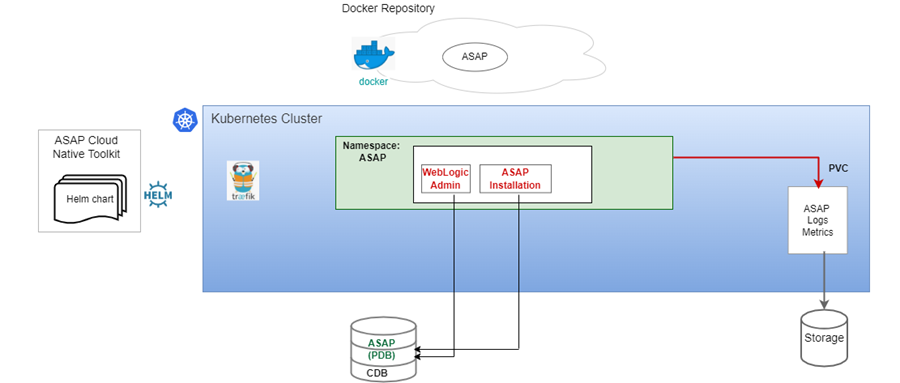1 Overview of the ASAP Cloud Native Deployment
Get an overview of Oracle Communications ASAP cloud native deployment, architecture, and the ASAP cloud native toolkit.
This chapter provides an overview of Oracle Communications ASAP deployed in a cloud native environment using container images and a Kubernetes cluster.
About the ASAP Cloud Native Deployment
You set up your own cloud native environment and can then use the ASAP cloud native toolkit to automate the deployment of ASAP instances. By leveraging the pre-configured Helm charts, you can deploy ASAP instances quickly ensuring your services are up and running in far less time than a traditional deployment. However, there are a few differences between traditional and cloud native deployments. For more information, see "Differences Between ASAP Cloud Native and ASAP Traditional Deployments".
ASAP cloud native supports the following deployment models:
-
On Private Kubernetes Cluster: ASAP cloud native is certified for a general deployment of Kubernetes.
-
On Oracle Cloud Infrastructure Container Engine for Kubernetes (OKE): ASAP cloud native is certified to run on Oracle's hosted Kubernetes OKE service.
ASAP Cloud Native Architecture
This section describes and illustrates the ASAP cloud native architecture and the deployment environment.
The following diagram illustrates the ASAP cloud native architecture.
The ASAP cloud native architecture requires components such as the Kubernetes cluster. The WebLogic domain is static in the Kubernetes cluster. For any modifications, you should update the ASAP Image and redeploy it. The ASAP cloud native artifacts include a container image built using Podman and the ASAP cloud native toolkit.
Downloading the ASAP Cloud Native Artifacts
To deploy ASAP and Order Balancer cloud native instances in the Kubernetes cluster:
- Download the cloud native tar file, for example
ASAP.R7_4_0_Px.Bversion.cn.tar from Oracle
Software Delivery Cloud or from My Oracle Support Website.
Note:
The cloud native tar file is present in the Linux platform only.Where x is the patch set version of the ASAP cloud native.
version is the release version of the ASAP cloud native.
- Copy the tar file to the machine where Podman and Kubernetes are installed.
- Extract the tar file using the following
command:
tar -xvf ASAP.R7_4_0_Px.Bversion.cn.tarThe artifacts in the tar file are extracted to the same directory where you ran the command.
The following zip files are extracted:- asap-img-builder.zip: To build ASAP image and Order Balancer image.
- asap-cntk.zip: To create ASAP instance.
- ob-cntk.zip: To create Order Balancer instance.
About the ASAP Image Toolkit
The ASAP image builder toolkit (asap-img-builder.zip) creates an image with a base image as Linux 8 and installs prerequisite packages, Java, WebLogic Server, database client, and ASAP. The toolkit contains scripts to install the required packages and installers.
The image building process consists of manual steps. ASAP database is not part of the ASAP Image. The database should be accessible from Podman host machine and the Kubernetes cluster.
About ASAP Instance
The ASAP instance in the Kubernetes cluster includes deployment, service, and Ingress route. The ASAP Image is created using the image builder toolkit, which deploys the ASAP instance in the Kubernetes cluster by using the ASAP cloud native toolkit.
Once the instance is up, you should not perform any configuration changes such as deploying a new cartridge, changing configuration parameters, and so on. If you want to perform such changes, update the ASAP Image and redeploy the instance.
About the ASAP Cloud Native Toolkit
The ASAP cloud native toolkit (asap-cntk.zip) is an archive file that includes utility scripts and samples to deploy ASAP in a cloud native environment.
Contents of the ASAP Cloud Native Toolkit
The ASAP cloud native toolkit contains the following artifacts:
- Helm charts for ASAP which are located in the
asap_cntk/charts/asapdirectory. - Scripts to manage the lifecycle of an ASAP instance
